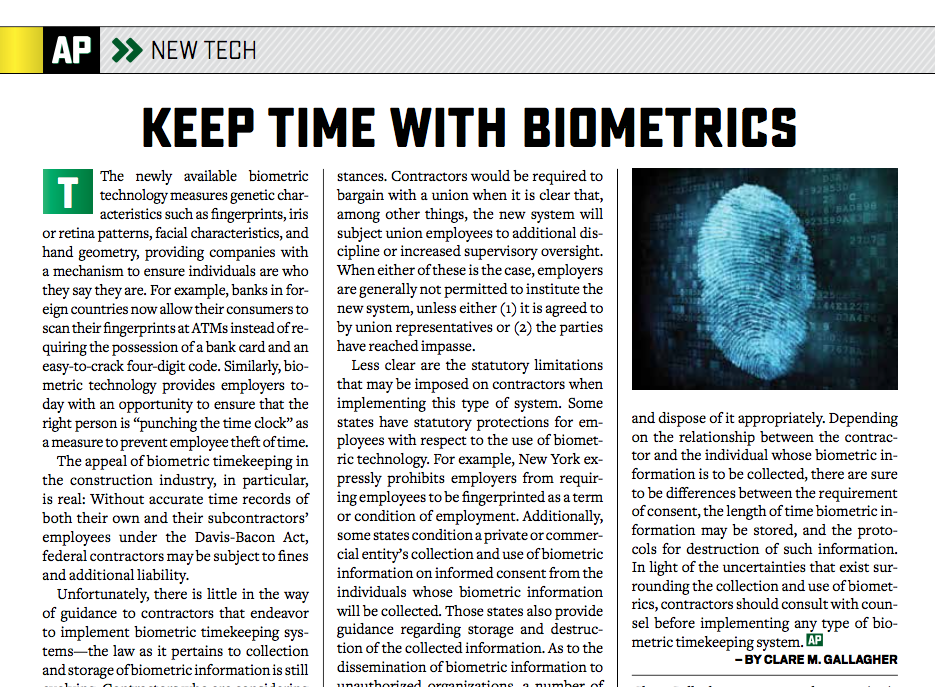Keep Time with Biometric Timekeeping
BY Clare M. Gallagher

The newly available biometric technology measures genetic characteristics such as fingerprints, iris or retina patterns, facial characteristics, and hand geometry, providing companies with a mechanism to ensure individuals are who they say they are. For example, banks in foreign countries now allow their consumers to scan their fingerprints at ATMs instead of requiring the possession of a bank card and an easy-to-crack four-digit code. Similarly, biometric technology provides employers today with an opportunity to ensure that the right person is “punching the time clock” as a measure to prevent employee theft of time.
The appeal of biometric timekeeping in the construction industry, in particular, is real: Without accurate time records of both its own and its subcontractors’ employees under the Davis-Bacon Act, federal contractors may be subject to fines and additional liability.
Unfortunately, there is little in the way of guidance to contractors that endeavor to implement biometric timekeeping systems—the law as it pertains to collection and storage of biometric information is still evolving. Contractors who are considering using biometric information as a means to track time should be aware of the implications on both their and their subcontractors’ employees.
First, contractors dealing with unionized workforces should keep in mind their duty to bargain in good faith before implementing biometric timekeeping systems. Although the National Labor Relations Board (NLRB) appears receptive to the new technology as a means of timekeeping, its decisions caution that employers are required to bargain with a union in certain circumstances. Contractors would be required to bargain with a union when it is clear that, among other things, the new system will subject unit employees to additional discipline or increased supervisory oversight. When either of these is the case, employers are generally not permitted to institute the new system, unless either (1) it is agreed to by union representatives or (2) the parties have reached impasse.
Less clear are the statutory limitations that may be imposed on contractors when implementing this type of system. Some states have statutory protections for employees with respect to the use of biometric technology. For example, New York expressly prohibits employers from requiring employees to be fingerprinted as a term or condition of employment. Additionally, some states condition a private or commercial entity’s collection and use of biometric information on informed consent from the individuals whose biometric information will be collected. Those states also provide guidance regarding storage and destruction of the collected information. As to the dissemination of biometric information to unauthorized organizations, a number of states require an entity to (at the very least) provide notice to the individual that a security breach has occurred.
Other states, including Pennsylvania and Ohio, have yet to address the use of biometric technology in the employment setting. Interestingly enough, however, even in states in which the legislature has yet to adopt a stance on collection or dissemination of biometric data, contractors may face yet additional obstacles to biometric timekeeping. One West Virginia federal court decision, for example, found that an employee whose religious views conflicted with an employer’s use of biometric technology was entitled to a religious accommodation under federal anti-discrimination law.
Assuming you are operating in a state that does not prohibit the collection of biometric information, a best practice is to always obtain a consent to the collection of the data, secure the information properly, and dispose of it appropriately. Depending on the relationship between the contractor and the individual whose biometric information is to be collected, there are sure to be differences between the requirement of consent, the length of time biometric information may be stored, and the protocols for destruction of such information. In light of the uncertainties that exist surrounding the collection and use of biometrics, contractors should consult with counsel before implementing any type of biometric timekeeping system.
Clare Gallagher concentrates her practice in traditional labor law, employment law and litigation. Prior to joining Eckert Seamans, Gallagher served as legal counsel and director of human resources for a large title agency in the real estate services industry. There she managed legal matters, including class action litigation and oversight of outside counsel, acquisitions, corporate finance, governance, and employment-related legal matters.
Eckert Seamans Cherin & Mellott LLC has nearly 375 attorneys located in 14 offices throughout the United States. The firm provides a broad range of legal services in the areas of litigation, including mass tort and products liability litigation, corporate and business law, intellectual property law, labor and employment relations, aviation law, bankruptcy and creditors’ rights, employee benefits, environmental law, construction law, public finance, real estate, tax and estate law, and trucking and transportation law. For more information about the firm, please visit www.eckertseamans.com.
